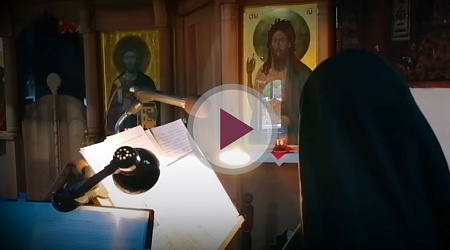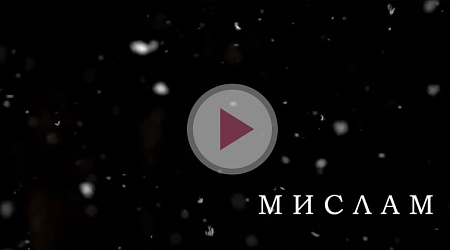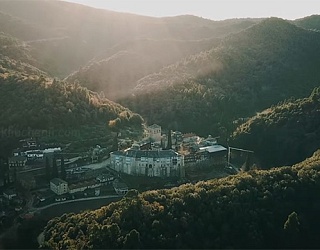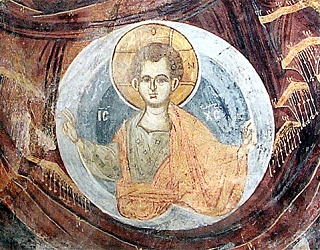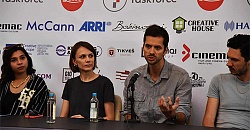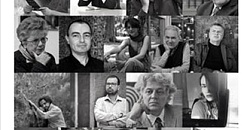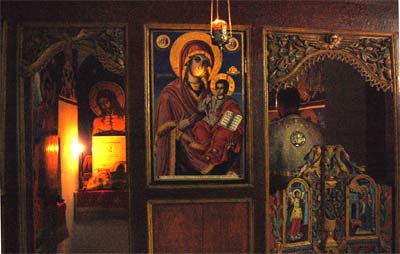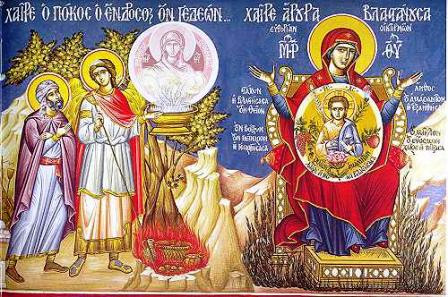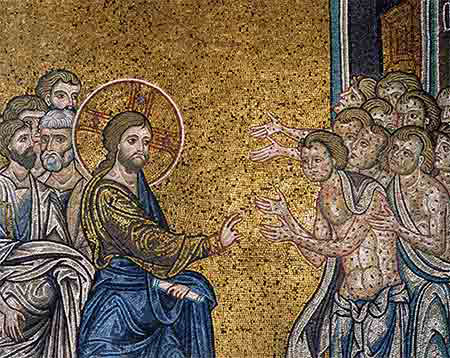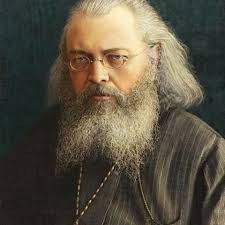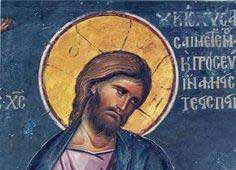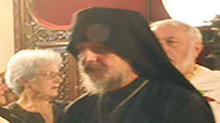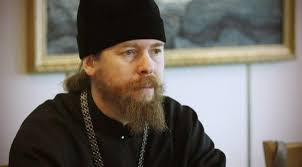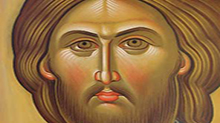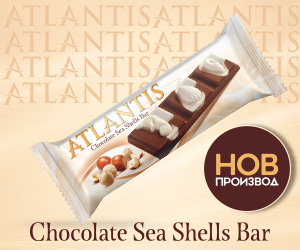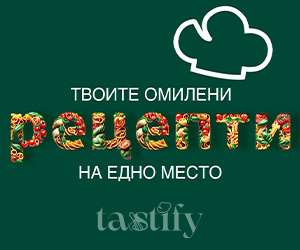НАУЧНА КОНФЕРЕНЦИЈА
НАУКАТА И УМЕТНОСТА 2
ПРОГРАМА И КНИГА НА АПСТРАКТИ
WISSENSCHAFTLICHE KONFERENZ
WISSENSCHAFT UND KUNST 2
DAS PROGRAMM
UND DAS BUCH MIT ZUSAMMENFASSUNGEN
Охрид, 20–21 септември 2015
Ohrid, 20–21 September 2015
20 септември (недела) / 20 September (Sonntag)
10:00
Поздравни обраќања
Акад. Владо Камбовски, претседател на МАНУ
Проф. д-р Армин Јене, потпретседател на Научното друштво од Берлин „Лајбниц“
Grußworte
Akad. Vlado Kambovski, Präsident der Makedonischen Akademie der Wissenschaften und Künste
Prof. Dr. Armin Jähne, Vizepräsident der Leibniz-Sozietät der Wissenschaften zu Berlin e. V.
Работен дел / Arbeitsteil
Општествени науки / Sozialwissenschaften
Витомир Митевски
Определба на поимот философија од Св. Константин–Кирил и античката традиција
Vitomir Mitevski
Bestimmung des Begriffs Philosophie von Hl. Konstantin–Kyrill und die alte Tradition
Ханс Ото Дил
Од толеранција до слобода: просветувањето од Франција до Балканот
Hans Otto Dill
Von Toleranz zu Freiheit: die Aufklärung von Frankreich bis auf dem Balkan
Цветан Грозданов
Културното наследство на РМ (фрескоживописот и иконописот)
во германската историографија
Cvetan Grozdanov
Das kulturelle Erbe der Republik Makedonien (Fresken und Ikonen)
in der deutschen Geschichtsschreibung
Армин Јене, Свобода Јене
Уметноста и реалноста. Словенско-балканската периферијата на европскиот културен простор во првата
третина од 20-от век
Armin Jähne, Svoboda Jähne
Kunst und Wirklichkeit. Die slawisch-balkanische Peripherie
des europäischen Kulturraums im 1. Drittel des 20. Jahrhunderts
Катица Ќулавкова
Книжевната херменевтика (нови пристапи)
Katica Kulavkova
Literarische Hermeneutik (neue Ansätze)
П а у з а / P a u s e
1
Владо Камбовски
Предизвиците на правната држава и човековите права во РМ
Vlado Kambovski
Herausforderungen des Rechtsstaates und die Menschenrechte in der Republik Makedonien
Таки Фити
Големата рецесија и одговорот на фискалната политика –
фискална строгост наспроти фискални стимули
Taki Fiti
Die Große Rezession und die Reaktion der Finanzpolitik –
Finanzielle Sparmaßnahmen gegenüber Finanzstimuli
Гоце Петрески
Порастот на населението и економскиот развој –
глобалните трендови и меѓусебните односи
Goce Petreski Bevölkerungswachstum und wirtschaftliche Entwicklung – Globale Trends und
Wechselbeziehungen
Петер Рау
Германската и македонската критика. Бездни и мостови
Peter Rau
Die deutsche und die makedonische Kritik. Abgründe und Brücken
Д и с к у с и ј а / D i s k u s s i o n
2
21 септември (понеделник)
21 September (Montag)
10:00
Работен дел / Arbeitsteil
Life Sciences
Луц Флајшер
Забелешки за конструктивната и критичка тријалектика на здравјето,
исхраната и прехранбената технологија
Lutz Fleischer
Einwürfe zur konstruktiven und kritischen Trialektik von Gesundheit, Ernährung und
Lebensmitteltechnologie
Нада Поп-Јорданова, Јордан Поп-Јорданов
Интеракција мозок–мисла: теорија и примена
Nada Pop-Jordanova, Jordan Pop-Jordanov
Interaktion Gehirn–Gedanke: Theorie und Anwendung
Момир Поленаковиќ, Катарина Давалиева
Протеомиката во откривањето биомаркери за карцином на простатата
Momir Polenakovic, Katarina Davalieva
Proteomik in Entdeckung von Biomarkern für Prostatakarzinom
Волфганг Шит
Нанотехнологијата во биомедицинските истражувања и клиничката медицина
Wolfgang Schütt
Nanotechnologie in der biomedizinischen Forschung und der Klinischen Medizin
П а у з а / P a u s e
3
Луан Старова
Меморијата на животот во Охридското Езеро низ миграциите на живите суштества во времињата
Luan Starova
Erinnerung an das Leben im Ohrid-See durch die Migration von Lebewesen in den Zeiten
Владо Матевски
Планински ендемити во флората на Република Македонија
(со посебен осврт на планината Галичица)
Vlado Matevski
Gebirgsendemiten in der Flora in der Republik Makedonien
(mit speziellem Übersicht über die Galičica-Gebirge)
Златко Левков и соработници
1,5 милиони години еволутивна историја: потекло, специјација и изумирање на диатомите во Охридското
Езеро
Zlatko Levkov et al.
1,5 Millionen Jahre Evolutionsgeschichte: Herkunft, Speziation und Extinktion von Kieselalgen im
Ohrid-See
Катерина Бачева Андоновска, Трајче Стафилов, Владо Матевски
Биорасположливост и биоакумулација на токсични елементи
во различни видови на растенија во областа на напуштениот рудник за Аs-Sb-Tl Алшар, Република
Македонија
Katerina Bačeva Andonovska, Trajče Stafilov, Vlado Matevski Bioverfügbarkeit und Bioakkumulation
von toxischen Elementen in verschiedenen Pflanzenarten im Bereich der verlassenen Mine für die
As-Sb-Tl Alshar, Republik Makedonien
Снежана Милковска, Владо Матевски, Елена Колевска
Календар на полен и алергии во Република Македонија
Snežana Milkovska, Vlado Matevski, Elena Kolevska
Pollen- und Аllergienkalender in der Republik Makedonien
Д и с к у с и ј а / D i s k u s s i o n
4
Definition of Philosophy by St. Constantin-Cyril and Ancient Tradition
Vitomir Mitevski
Macedonian Academy of Sciences and Arts,
Krste Misirkov 2, MK-1000 Skopje, Republic of Macedonia
During the last half of the XX Century there were many attempts of interpretation of St.
Konstantin-Cyril definition of philosophy as presented in the Large biography by St. Clement of
Ohrid. In the meantime is distinguished the attitude that the definition is written under the
influence of three kind of tradition: ancient and neoplatonic philosophy, Byzantine philosophical
tradition and Christianity.
In this paper is paid attention on the ancient philosophy (especially on pythagoreanism and Plato)
with intention to be pointed exactly the crucial elements (ideas incorporated in the St. Konstantin
definition) given as old patterns used in the Christian context.
5
From Tolerance to Freedom: the Way of Enlightenment from France to the Balcans
Hans-Otto Dill
Pillauer Str. 5
D 10243 Berlin
(Post)modern philosophers are today at the odds with the Enlightenment (Aufklärung), because
according to them, that philosophy belongs to the past time and has nothing to do with our 21.th
century. Enlightenment today is really forgotten. Very seldom in the actual debates are mentioned
thinkers of the Enlightenment as Lamettrie, Diderot, Voltaire, d Àlembert, Helvétius or
Holbach, and Rousseau is the target of accusations to be a forerunner of fascism. Just on
the contrary, adversaries of rationalism like Nietzsche, Heidegger, Schleiermacher, Dilthey,
Bergson, and occupy the foreground. But in my opinion Enlightenment constitutes one of the most
important intellectual movements of the History of Mankind and also of our time. How can we resolve
such contradiction?
1) I will show that we have to make a difference between three things: Enlightenment as Philosophy,
Enlightenment as Literature or esthetical and artistic movement, and Enlightenment as a political
movement for every-day-life-wisdom, far from each theory, expressing only life practical purposes.
Only the letter interests me.
2) Enlightenment began with a claim and a movement for religious tolerance in France. Its most
influent representatives have been Pierre Bayle, Voltaire and the King of Prussia, Frederick II,
culturally not German, but French. This tolerance movement became by a surprising change the
so-called Enlightenment movement, which I will try to explain.
Tolerance became in the French eighteenth century a movement based on Science and Experience
against superstition and myth and also against spiritual and political authoritism or dictatorship
and for democracy, which means freedom, equality, the Rights of Man and Citizen and the Right of
Otherness. These values also today are respected by the UNO and the different constitution of the
democratic countries.
3) But the Enlightenment not only became a political movement of the eighteenth century in France,
as its French and Spanish names may associate-le siècle des lumières or El siglo de las luces - but
needed also a temporary extension till to our days and till to the future, because man is not born
free and democratic, but needs always an education in these fields by society. And we have in the
world at the same time peoples and nations with different social, political, economic and cultural
levels, which means that some peoples have a later level than others. I think particularly in the
so-called Third World.
4) This includes too admitting that Enlightenment is also a spatial or geographical phenomenon, a
world project, because the nations and peoples have different political economic and cultural
levels. Therefore Enlightenment wandered from England and France, its two motherlands, to Germany,
Italy, the Pyrenees (Spain and Portugal) and the Americas, and also to the Balkans, which I will
try to discuss in a particular manner. We have to admit with Herder that only a small part of the
humanity participates hitherto in the Enlightenment, principally in the so called First World, in
the Occident.
6
Cultural Heritage of the Republic of Macedonia (Frescoes and Icons)
in the German Historiography
Cvetan Grozdanov
Macedonian Academy of Sciences and Arts,
Krste Misirkov 2, MK-1000 Skopje, Republic of Macedonia
The contribution of the historians of art from Germany to the study of the cultural heritage of
Macedonia is great. It is therefore not surprising that the names of historians of art from Germany
are so present with their cited works not only in Macedonia, but also around the world.
Karl Krumbacher (1856-1909) even after a century since his end is still quoted with his major work
Geshichte der byzantinischen Literatur von Justinian bis zum Ende des Oströmischen Reiches, 2 Aufl
(München 1897), which is an unsurpassed book, not only concerning literature but also history,
culture and the religious issues of Byzantium, within which borders was Macedonia for several
centuries. His contemporary is Heinrich Gelzer who in 1902 in Leipzig published his book, which is
also actual today, Der Patriachat w Ohrida. Of course, these books are not devoted to fine arts but
to the circumstances and the people who have created works of art and who has created the climate
of the cultural life.
Almost the same year begins the publication of the specialized Byzantine annual publication
Byzantinische Zeitschrift, which will become a prominent center for the latest studies of Byzantine
history, culture and art. Of course, the Macedonian issue is here equivalently present. Do we need
to mention that this renowned journal is also published today and it is the focused of the leading
experts on this issue.
The publication of Byzantinische Zeitschrift affected the establishment of the prominent Byzantine
center under the Turkish Empire in Constantinople headed by the great Russian scientists Uspenski
and Florinski, who began publishing the Annual “Izvestia” of the Russian Archaeological Institute
in Constantinople. This center was concentrated on studying the Slavic culture and art
within the Ottoman Empire, especially during St. Cyril and Methodius and Clement. The Annual was
published under the auspices of the Russian Tsar and field research have been conducted,
particularly in Prespa and Ohrid, searching for the remains of states of Samuel and the era of
Clement.
Concerning the Byzantine science and foremost the monuments of the epoch of the Palaeologus in
Macedonia, even today, of capital importance is the plenary lecture of prof. Oto Demus “Die
Entstehung”, presented at the XI International Byzantine Congress held in Munich in 1958. The topic
of his study, and the main theme of the congress was about the development of the Renaissance of
the Palaeologus in painting according to the monuments of XIII and XIV century. The evolution of
forms in regards to the previous era of the Comnenus and the maturation of new forms during the
second half of the XIII century until the classicism in the middle of XIV century were the subject
of a deep study, where an evolution was established through which passed art and its aesthetics
during the dynasty of the Palaeologus. This paper of Professor Demus even today is a basic paper
about the capital artistic monuments such as Sopocani, Milesevo, Gradec and the frescoes of the
great painters Michael and Eutychius. In the focus is the fresco paining in Peribleptos in Ohrid
(today St. Clement) from 1295, then in Staro Nagoricane – Kumanovo, St. Nikita - Skopje, Gracanica,
Kraljeva Church, done in the period of the reign of King Milutin in the Serbian state and
Macedonia. Particularly specific are the studies of the influence of the ancient art, the formal
innovations, the contacts with the Italian art (Florence) and their interlinking in the period of
the proto Renaissance in Italy.
7
This great researcher revisits the fundamental issues in Macedonia in the paper at the XII
International Byzantine Congress in Ohrid, 1961, concerning the report of V. N. Lazarev
about the art of Macedonia in XI and XII century. Unlike Professors S. Radojcic and
S.Penikanidis he raised the issue about the impact of the Slavic factor of the St.
Clement School in the development of art in Macedonia in the second half of the XII century,
as is the case with the “baroque” elements in the Kurbinovo style, versus the classical features of
the frescoes in Nerezi.
Two personalities from the German circle of Byzantinists left the deepest traces in the study of
the monuments in Macedonia and Serbia and traces of their publication are very present even today.
These are historians of art Richard Hamann-Mac Lean and Horst Hallensleben. They round out the
territories of Macedonia and Serbia, i.e. their monuments from XI to mid XIV century. Their books
are printed in Giesen, the first volume in 1963 and the second volume in 1976. We present their
titles: Richard Hamann-Mac Lean: Die Monumentalmalerei in Serbien und Makedonien and Richard
Hamann-Mac Lean: Den Freunden und Kollegen in Jugoslawien gewidmet.
Chronologically is studied the fresco painting in St. Sophia in Ohrid, Nerezi, Kurbinovo the
churches in Prilep from XIII century, the frescoes and icons in Ohrid from the XIII century, St.
John Kaneo. The authors seek to explain the style together with the iconography and to unravel the
complex theological scenes and their place in the Byzantine world. The books are
printed with rich illustrations, photographs and architectural plans with the numbering of themes
in the temples. The authors tried to use the overall existing literature on these monuments
published in the years up to the printing of these books. This approach has contributed
today these books to be renowned and inevitable in any study of the monuments in question.
Having in mind the situation with the country at that time, here are also the temples on the
territory of Serbia from Studenica and Sopocani to Moravian Serbia, which, on this occasion, we
would not comment.
For their persistence, systematic work and effort to illuminate this period of art history in the
Balkans, both authors are honored, and we express our gratitude. After these fundamental books,
there are maybe only two or three attempts to study this very important period for the culture of
Macedonia, the Balkans, and also in European terms.
Chronologically the oldest is the scientific report about one of our monuments in Germany, which is
the Munich Psalter, which originated in the late XIV century. Until today, the major book on this
monument of culture and art is the publication of 1906 by the author Strzygowski J., Die Miniaturen
des serbischen Psaltres der Königl. Hof-und Staatsbibliothek in München, Wien 1906. The Psalter is
decorated with numerous miniatures, figural performances and compositions. This illumination has
provoked a great interest among the professional public, so that almost immediately after the
publication it has been commented by the leading representatives of the Byzantology, for e.g., in
Russia and France. Charles Diehl wrote about it in his review of Byzantine art, as well as Nikodin
P. Kondakov in his books about Macedonia and the illumination in Byzantine art. Although the Munich
Psalter does not have preserved parts about the time and place of origin, even at the end of the
first decade of the XX century unanimous views were expressed that the manuscript has been made in
the last quarter of the XIV century originating in Northern Macedonia, i.e. the border regions with
Serbia. Strzygowski with this monumental publication has enabled the Munich Psalter to be compared
with a series of presentations from the fresco paintings, and thus, series of analogies have been
found in the region of Marko's Monastery, Staro Nagoricane, Psaca, which points to the region of
inspiration of the craftsmen who collaborated with the fresco painters.
Even today, the Munich Psalter occupies a prominent place in the history of art, and its
comparative study continues today. It will be very useful and necessary after more than 100 years
to publish a new monograph on the Munich Psalter in which will be included observations of
prominent authors who have written after 1906. In addition, it will be of interest to study the
illumination with the ornaments in a parallel line with the decoration of the other manuscripts
from this region.
8
Art and Reality. Slavic Balkan Periphery in the European Cultural
Panorama in the First Third of the 20th Century
Svoboda Jähne, Armin Jähne
In this study, an attempt is made to trace certain aspects related to the creation and development
of the movement for Native art as social and aesthetic phenomenon. For us it is important to
understand its nature and its specific artistic realization, to find unity of the mutually
conditioned causal relations of different character and to determine the mutual relations of their
components.
1. Because the movement for Native art is not only a temporary factor, but an important stage in
the development of the Bulgarian culture.
2. Because it is a feature of the cultural history of Bulgaria in the years between the First and
the Second World War, i.e. the period we are interested in.
3. Because this artistic movement did not exhaust and disappear in the 20s of last century, but on
the contrary, continues to exist as style plastic concept to this day, but reaches its zenith in
the 20s.
4. Because the movement for Native art affects a new aspect of the problem “intelligentsia - people
(a community)”, i.e., it means its spiritual approximation. As a result of this process of
approximation many intellectuals began, with open eyes, to monitor and see, in the politically
complex and emotionally tense postwar atmosphere, the tragic contradictions of the existent
social order, to question its uprightness and to partly skeptically deny it.
5. Because within the movement for Native art the socio-critical tendencies began to spread and to
establish. And there is the fact that in the works of some artists like Vasil Stoilov, Zlatyu
Boyadzhiev and Kiril Petrov the abstract humanistic notions of good and evil, which are
characteristic for many supporters to the movement for Native art receive a social nuance, they
become socially differentiated. In some works of Canko Lavrenov Ivan Milev and others the
antifascist tendencies lose their veiled, symbolic and character and become particularly specific.
Other artists such as Pencho Georgiev and Stoyan Venev depict expressively the city and village in
its sharpest social aspects. The objectives to be addressed are: to search for the reasons that
cause this art movement; to clarify the contradictory nature of the movement for Native art, the
complex of ideas and opinions and their realization in the artistic practice; to clarify the
“national” in it, which, in practice, is directly dependent on the socio-economic structure and
the political situation in Bulgaria in that time; to consider various factors (socio-political,
socio-cultural); the social position of the artist; the national (internal) and international
(external) pulses, which influence the movement for Native art.
9
Challenges to the Rule of Law and the Human Rights in the Republic of Macedonia
Vlado Kambovski
Macedonian Academy of Sciences and Arts,
Krste Misirkov 2, MK-1000 Skopje, Republic of Macedonia
In the eve of the 25th anniversary of the proclamation of independence (the Referendum on
independence was held on September 8, and the Constitution was proclaimed in November
1991), is standing on a historic crossroads. Although prolonged, it has passed the path of “double
transition” through democratization and marketization of the society. By establishing the political
system, the economy of the democratic principles of political pluralism and the free and open
market, the core values, ideology and institutions of the former socialist society have been
abandoned. However, the current deep political crisis in which the Republic of Macedonia is today
leads to the conclusion that the “double transition” did not give the expected results in return
for the nature of governance and management of the social affairs and the institutions of the
previous political, economic and legal system. The accumulated contradictions that challenge it are
in line of neglecting the postulates of the transition as a complementary process that, apart from
the democratization and marketization, also covers the state of law and the multinational
integralism, as conditions for a stable society integrated into the common European prospects.
The Macedonian society stands before the opening of a new development phase of “post transition”,
which, at its core, has the realization of two basic principles: the democratic rule of law and the
citizens' sovereignty with domination of the respect for human rights and freedoms, including the
collective ones, and their equality as a prerequisite for an integrated multicultural society.
Sharing this position that implies courageous political decision-making is the basis of the
agreements reached to overcome the crisis among the largest parliamentary parties of 2 June and 15
July 2015, which cover the recommendations contained in the Report of the Expert Group of the EU,
led by R. Pribe, of June 8, 2015.
The establishment of the Republic of Macedonia as a democratic constitutional country, based on the
rule of law and the priority of respect of the human rights and freedoms is not an act of
declaratively expressed political will, but above and beyond all, is a matter of a rationally based
selection of methods and means to expand the space for human freedom and dignity in a given social
context and a process of establishment of new social relations, principles and institutions. Here,
it would be of help to rely on science, culture and art, because free society is primarily a
society of freedom of the spirit and the creativity.
10
The Great Recession and the Fiscal Policy Response –
Fiscal Austerity vs Fiscal Stimulus
Taki Fiti
Macedonian Academy of Sciences and Arts,
Krste Misirkov 2, MK-1000 Skopje, Republic of Macedonia
The author of this paper argues that during large crises, due to the presence of the liquidity trap
phenomenon, the efficiency of monetary policy is questioned, the credit function of commercial
banks freezes and governments reach for measures of expansionary fiscal policy to insure the
recovery of economies. This happened during the Great Depression of 1929 –
1933 as well as during the Great Recession of 2007 – 2009. However, one of the greatest weaknesses
of expansionary fiscal policy during severe and prolonged recessions is the expansion of structural
budget deficits and the enormous rise of public debt. Two opposing or better yet competitive
conceptions appeared in the post-crisis debates in the contemporary macroeconomic science regarding
the fiscal policy response. One argues for a large amount of fiscal stimulus, adequate to the
severity of the recession, while the other one argues for fiscal austerity, especially if the
fiscal space is substantially narrowed (depleted). The author illustrates the two different
conceptions with the cases of Germany and Macedonia. Germany, which is included in the group of
countries that promote fiscal austerity, according to the author, de facto responded to the
challenges of the Great Recession by implementing a prudent fiscal policy. Macedonia, on the other
hand, with a continuous growth of budget deficits in the last five – six years, doubled its public
debt and irrationally depleted the fiscal space created before the crisis. The author, based on the
new knowledge of macroeconomic science on the role of fiscal policy during drawn-out recession,
summarizes the arguments in favour of fiscal stimulus and those in favour of fiscal austerity. The
main arguments for using large fiscal stimuli are the following: (1) in a liquidity trap, when
monetary policy is inefficient and the crediting of households and businesses, despite the low
nominal interest rates, is difficult to return, fiscal policy proves to be a powerful lever for
recovery of economies. This assessment is consistent with the argument that the efficiency of
fiscal stimulus is larger when the banking system is dysfunctional, and the fiscal policy is
inexpensive in terms of low interest costs on debt; (2) despite the large differences in the
estimates of the value of the fiscal multipliers, the efficiency of the fiscal stimulus can be
additionally enhanced if they correspond to the severity of the crisis in terms of amount,
composition and timeline; (3) the efficiency of fiscal policy is higher during deep crises and
questionable efficiency of monetary policy, since it is less expensive regarding the possibility to
increase the debt burden at low interest rates; (4) the most significant weakness of expansionary
fiscal policy can be alleviated if governments create enough fiscal space in “good times”, which
would enable the fiscal policy to help the economy recover in times of crisis. The arguments in
favour of fiscal austerity refer to the following: (1) discretionary fiscal policy, due to the long
inside time lag, is often counterproductive; (2) the positive effects of fiscal expansion on output
and employment are limited and profiled only in the short run – in the medium run the growth of GDP
slows down, and in the long run, the
11
economic growth rates fall; (3) the large public debt is accompanied by direct and indirect
crowding out – effect, a decrease in savings and adverse effects on the structure of real GDP; (4)
the large public debt depletes the fiscal space and imposes the need for fiscal
consolidation as a complex, long-term and difficult process.
The final conclusion of the author is that there is neither unanimous answer nor an easy choice
when it comes to solving the dilemma – fiscal stimulus or fiscal austerity. One fact remains –
during severe recessions governments regularly reach for measures of expansionary
fiscal policy. However, the amount of these stimulus and its duration depends on the simultaneous
and parallel effect of numerous factors: the severity of the recession, the basic economic
performances of the particular economy (whether it is a small or large country, the level of
its development, i.e. per capita income, the trade openness of the country, the exchange rate
regime, the strength of the automatic stabilizers etc.), the available fiscal space (which is
directly related to the size of the country’s public debt) etc.
12
Population Growth and Economic Development –
Global Trends and Interrelations
Goce Petreski
Macedonian Academy of Sciences and Arts e-mail: Оваа е-адреса е заштитена од спамботови. Треба да ви е овозможено JavaScript за да ја видите.
It is plausibly realistic to anticipate over nine billion people living on the earth by 2050.
Historic shifts in the world population, its absolute growth, and perhaps more importantly, its
geographical distribution and age structure will exert tremendous pressures entailing a profound
change of existing and evolving political, economic and demographic balances. From one side, the
population dynamics brings up an immense potential in human resources for economic growth, on the
other, it puts a weighty pressures for redistribution of limited resources.
The uneven population growth and dissimilar demographic patterns tend to draw
transnational migrations on a large scale. In the coming few decades the world is about to face an
endogenously rising demand for profound economic, social, political, technological, ethnic and
other related structural transformations, in all probability, resulting in alterations in economic
power. Deep and compressed changes, globally, regionally and nationally, would emerge as
inevitable. In response to emerging challenges there is an inevitability of building up a global
consensus on development and other policies, in order to avoid major frictions and collides, caused
by climate change, lack of food security, ethnic and religious conflicts.
The aim of the paper is to explore the implications of population growth related to predominantly
economic issues, the change of productive space, resource and other constraints, consumption,
distribution and environment. A particular emphasis will be put on related regional and national
implications.
Key words: global population, trends, economic growth, development
13
Remarks on the Constructive and Critical Trialectics of Health, Nutrition and Food Technology
Lutz-Günther Fleischer, MLS
Human civilization is facing a growing number of globally and regionally differentiated essential
societal problems with manifold social determinants of high complexity / cooperativity, ambivalence
and polarity. Of special importance are those that are merely outlined with keywords such as
energy, raw materials, food, health, reproductive behavior of people, environmental quality,
information and education, and which interact extremely contradictory.
The quantitatively absolutely dominant part of current industrial food production can hardly be
distinguished from the production of other industrial products. Technological and economic
considerations serve as absolutized quality characteristics and, under certain circumstances, as
decision criteria with enormous implications. But food and beverages are biotic products with
unical characteristics and unique requirement profiles, in particular with regard to the
nutritional and health-related food quality, because of their vegetal and animal origins. An
additional benefit is expected to be achieved with health ingredients and novel / functional food
by adding or implementing new functionality. Nutritionally conscious consumers are tending to
consume comfort foods and stimulants promising an enhanced health or causing feel-good effects.
Foods secure growth, anabolism and catabolism, mainly cover the highly differentiated material and
energy nutritional needs, receive and condition the highly complex human organism. Comfort foods
and stimulants stimulate the secretion, the nervous system, especially the sensory organs, but also
the cardiovascular system and the gastrointestinal tract.
From the development problems and problematic developments in the triad of health,
nutrition and food technology a number of conclusions (that need to be discussed further) as well
as qualifying requirements can be derived.
The adequate food supply for all people is a compelling human imperative. In general, the
unconditional primacy of nutritional quality in the development and production of food, the actual
product responsibility and transparency requirements for the global food industry as well as
comprehensive food safety in the “globalized pantry “ according to internationally binding,
comparable and controllable standards are to be required. This contribution is critically and
constructively discussing requirements, expectations and also illusions in human nutrition,
in food production and the food industry, attempting to integrate the various perspectives
mentioned above.
14
Key topics are:
functions and criteria of evolutionary food technology.
Significant trends in research and development in food technology.
New methods and new products; Goals and methods in functionalization of food; Functionalities
of the pro-, syn- and prebiotics.
Development, testing and use of health ingredients and novel / functional foods
(nutraceuticals) - presented on the basis of selected own findings.
15
Brain–Mind Interaction: Theory and Application
Nada Pop-Jordanova and Jordan Pop-Jordanov
Macedonian Academy of Sciences and Arts,
Krste Misirkov 2, MK-1000 Skopje, Republic of Macedonia
Recent advancements in the brain sciences have enabled researchers to determine locations and
patterns of neural activation associated with various psychological functions. However, the
mind-brain puzzle is complex and not yet elucidate. Some fundamental and practical aspects in this
interaction are considered through the study of arousal and attention. We discuss the
neuro-physical mechanisms underlying mind-brain interaction using some present classical and
quantum approaches, as well as transition probability concept of arousal, based on field-dipole
quantum interactions and information entropy.
This presentation proposes a theoretical approach to explain the characteristic empirical
interdependence between the states of arousal (representing the level of consciousness) and EEG
activity.
Mental arousal (as a general activation of the mind) is characterizing the level of consciousness
only, irrespective of its content. In 2005 we introduced a relevant parameter for calculation of
mental arousal we named brain-rate which is expressing the mean frequency of brain rhythms
i.e. EEG-spectrum weighted frequency.
Brain-rate can be considered as an integral brain state attribute correlated to brain electric,
mental and metabolic activity. In particular, it can serve as a preliminary diagnostic indicator of
general mental activation in addition to heart rate, blood pressure or temperature, as standard
indicators of general bodily activation.
We present the calculated brain-rate in different psycho-physiological disorders (ADHD, OCD,
anxiety, ASD etc.) in comparison to normal controls.
It was shown that as a measure of arousal, brain-rate can be applied to discriminate between the
groups of under-arousal and over-arousal disorders, as well as the subgroups within “mixed”
disorders, in particular the attention deficit hyperactivity disorder. Also, by comparing eyes
closed and eyes open brain rate values, the diagnosis of inner arousal can be simply achieved.
In addition, brain-rate values can be correlated to the sleep profile, helping to assess the
quality of sleep. In biofeedback treatment, brain-rate can be efficiently used as a multiband
biofeedback parameter, complementary to few-band parameters and skin conduction. Hereby, it is
especially suitable to reveal the patterns of sensitivity/rigidity of EEG spectrum,
including frequency bands related to permeability of corresponding neuronal circuits, based on
which the individually adapted biofeedback protocols can be elaborated.
In the future research we propose introducing brain-rate assessment and training, as a particular
form of neurofeedback modality, and also as a possible indicator of inner arousal related to many
mental activations changes (including induced by environmental toxins).
Key words: arousal, EEG, neurophysical mechanisms, brain-rate.
16
Proteomics in Biomarker Discovery for Prostate Cancer
Momir Polenakovic, Katarina Davalieva
Research Centre for Genetic Engineering and Biotechnology "Georgi D Efremov", Macedonian
Academy of Sciences and Arts, Skopje, R. Macedonia
Corresponding Author: Momir Polenakovic, Research Centre for Genetic Engineering and
Biotechnology "GeorgiD Efremov", Macedonian Academy of Sciences and Arts, Krste Misirkov 2,
1000 Skopje, R. Macedonia, Tel.: +389 (0)2 323 5400; Fax: +389 (0)2 323 5500; mob. +389 70 226
500 E-mail: Оваа е-адреса е заштитена од спамботови. Треба да ви е овозможено JavaScript за да ја видите., Оваа е-адреса е заштитена од спамботови. Треба да ви е овозможено JavaScript за да ја видите.
The use of prostate specific antigen (PSA)-based screening of prostate cancer (PCa) results with
over-diagnosis of the disease, unnecessary biopsies and high medical cost treatments. The discovery
of new biomarkers in blood, urine or tissue that will permit early detection and treatment of
patients with aggressive disease and, concomitantly, avoid overtreatment for low risk cases are
urgently needed.
Proteomic technologies are providing the tools needed to discover and identify disease associated
biomarkers. The application of these technologies to search for potential diagnostic/prognostic
biomarkers associated with PCa has shown constant growth in the last
15 years. The main clinical focus in PCa research nowadays is the discovery of biomarker(s) for
diagnosis and distinction between aggressive and indolent cancers, followed by prognostic
and response to treatment biomarker(s). Different proteomic technologies and various biological
samples have been analyzed with the aim of identifying diagnostic and prognostic biomarkers and
developing a deeper understanding of the disease at the molecular level.
This presentation will focus on the recent advances in PCa proteomics, emphasizing biomarker
discovery and their application for diagnosis and patient stratification.
Keywords: Prostate cancer, benign prostate hyperplasia, diagnostics biomarkers, comparative
proteomics.
17
Memory of Life in Lake Ohrid through the Migration of Living Beings in Time
Luan Starova
Macedonian Academy of Sciences and Arts,
Krste Misirkov 2, MK-1000 Skopje, Republic of Macedonia
The author in this paper builds on to his novel The Path of the Eels or Water Pyramid (published in
French, Russian, English, etc.), where using a global literary metaphor he tries to remind of the
need for urgent and pressing need for protection of Lake Ohrid, which is the oldest in Europe, and
according to recent surveys by experts it has been concluded that the lake is old 1.3 million
years, and is one with the greatest biodiversity worldwide. Lake Ohrid is home to over 350 endemic
species that are not found anywhere else in the world. However, in recent years, according to the
research by the eminent researchers from Germany (Dr. Thomas Wilke and Dr. Christian Albrecht,
Department of Animal Ecology and Systematics, University of Giessen, Germany), it has come to a
rapid decrease of the biodiversity of the Lake, which is mostly due to the social and political
factors and the environmental changes that are caused by man.
Through the metaphor of the fable path of the female eels (from the Lake and the mild river waters
of Crn Drim (in Macedonia) and the tributary of Bel Drim (in Albania), through the Mediterranean
Sea and the Atlantic Ocean to the Sargasso Sea, after the fertilization and the road back of the
born eels to the deltas of freshwater, the author focuses on the termination of this path, older
than the human presence, in the period of the socialist communism when two hydropower plants in
Macedonia and three in Albania were built in the spirit of Lenin's definition of socialism that
“socialism is electricity, electricity plus electricity”. In the period of transition and the
establishment of the Republic of Macedonia, eminent scientists have prepared a project (winner of
the first prize of the International Foundation Ford - USA) on how to enable the return of the
eels. Utopian projects have been proposed – to enable the return by way of parallel rivers, water
lifts and so on, but remains the problem of the code of returning of the eels, which is the
specific interest of the book's author. This paper presents an effort, an outcry to rescue the
lake, an effort to which the colleagues from the Leibniz Society should join us.
The paper will be accompanied by a short film story of the Path of the Eels, and a visit to the
Natural and Scientific Museum in Struga, created from the former collection of the famous
Belarusian Biologist Nikola Nezlobinski, which contains part of the Lake’s memory that does not
exist anymore.
18
Mountain Endemics in the Flora of the Republic of Macedonia
(with Special Overview to the Galichica Mt.)
Vlado Matevski
Macedonian Academy of Sciences and Arts,
Krste Misirkov 2, MK-1000 Skopje, Republic of Macedonia
The term endemism is defined as the occurrence of unique biodiversity that develops in a certain
area. One of the most important centers of endemism of higher plants in the Republic of Macedonia
are considered high mountains (Shar Planina Jakupica-Karadzica, Korab, Deshat, Jablanica,
Galichica, Pelister, Nidze), gorges of the major rivers (Vardar, Treska, Crna Reka, Pchinja,
Babuna) and some parts of the lowland belt (Mariovo, surroundings of Prilep – Treskavec, Sivec,
Pletvar, Kozjak, surroundings of Kavadarci - Alshar and the stepelike area - between Veles, Stip
and Negotino).
In the paper will be presented the mountain endemism in Macedonia, will be given an overview of the
endemic and subendemics species in the mountainous area, with one special attention overview to the
endemic species of the mountain Galichica.
The natural characteristics of Galicica Mt, location, geological history, relief and geological
substrate have contributed for the development of a exceptionally rich floral diversity, with over
1700 higher plant species, among which the endemic and relict species are of special importance.
Galicica Mt is a region with numerous species, representatives of various geo elements –
Mediterranean, Sub-Mediterranean, Oro-Mediterranean, Balkan, Scardo-Pindic, Central-European,
European, Alpine, and other. Galichica Mt. is a locus classicus to over 30 plant taxa, most of
which have a valid taxonomic status. The majority of species described are for the time being known
only within the boundaries of the mountain, so they are its local endemic or subendemic species.
Such is the case with the following species: Astragalus mayeri Micev., Bupleurum mayeri Micev.,
Centaurea galicicae Micev., Centaurea tomorosii Micev., Crocus cvijicii Košanin, Dianthus galicicae
Micev., Dianthus ochridanus Micev., Edraianthus horvatii Lakušić, Festuca galicicae Mgf-Dbg,
Helichrysum zivojinii Černjavski
& Soška, Laserpitium ochridanum Micev., Micromeria kosaninii Šilić, Nepeta ernesti-mayeri Diklić &
Nikolić, Sempervivum galicicum Micev., Jurinea micevskii Stevanović, Tan & Matevski and others.
19
1.5 Million Years of Evolutionary History: Origin, Speciation and Extinction of Diatoms in Ancient
Lake Ohrid
Zlatko Levkov1, Tomas Wilke2, Bernd Wagner3, Slavica Tofilovska1, Elena Jovanovska2 & Aleksandra
Cvetkoska4
1Institute of Biology, Ss. Cyril and Methodius University, Arhimedova 3, 1000 Skopje, Republic of
Macedonia
2Department of Animal Ecology and Systematics, Justus Liebig University Giessen,
Heinrich-Buff-Ring 26-32, 35392 Giessen, Germany
3Institute of Geology and Mineralogy, University of Cologne, Zülpicher Str. 49a,
50674 Köln, Germany
4Palaeoecology, Department of Physical Geography, Faculty of Geosciences, Utrecht University,
Heidelberglaan 2, Utrecht, The Netherlands
Ancient lakes are known as centers of high endemic freshwater biodiversity. The
evolutionary processes leading to high degree of biodiversity are still not well known. Recently,
two hypotheses have been proposed: (1) ancient lakes function as reservoirs for relic species, and
(2) they serve as sites for intralacustrine speciation. In the case of intralacustrine speciation,
often remains unknown whether their endemic species evolved shortly after the respective lake came
into existence or whether they are considerably younger than the lake. Lake Ohrid
(Macedonia/Albania) is among the very few lakes in the world holding a continuous sediment archive
of 1.5 Ma. Diatom application as proxies in palaeolimnological and palaeoclimate research in R.
Macedonia started at the end of 20th century. To date, several diatom records exist from Lake Ohrid
spanning up to 135.0 cal ka BP. In the spring 2013, a sediment sequence of ca. 550 m length was
recovered within the Scientific Collaboration on Past Speciation Conditions in Lake Ohrid ”SCOPSCO”
deep drilling campaign. The preliminary results indicate Lake Ohrid sediment sequence is unique by
its excellent diatom preservation. Diatoms appear on of the most of the important proxy to
reconstruct palaeoclimate, but also to understand the effects of the major geological/environmental
events on the evolution of the lake’s endemic biodiversity.
The preliminary observations of diatoms from the core catchers show existence of high morphological
diversity within the centric diatoms (morphospecies). Interestingly, most of the benthic diatom
species known from the contemporary flora in Lake Ohrid are present throughout the whole sequence.
However, only few species has not been recorded in the recent samples. Oppositely, the
composition of the planktonic diatoms is significantly shifting throughout the core. At least
nine Cyclotella and two Stephanodiscus species were not observed in the contemporary
flora and are considered as extinct. However, morphometric analyses on the
Cyclotella fottii complex show continuum in the morphological variations of the main
differential features, such as: outline, shape of the central area, presence/absence of colliculae
and granules in the central area etc. These observations might be considered as a good model for
following the evolutionary and speciation patterns within the genus Cyclotella. Phylogenetic
analyses based on morphological characters and molecular proxies, show that the endemic species
from the genera Rhoicoshenia and Surirella are paraphyletic. According to these studies,
the
20
endemism and the high diversity in Lake Horrid is most probably result of a combination of multiple
colonization events with subsequent intralacustrine speciation.
Further investigations will be focused on phylogenetic studies by using molecular and morphological
analyses, which could help to resolve the origin of the diversity and endemism;
reproductive studies will be included in order to explore the cryptic diversity and reproduction
strategies of different relict taxa. Additionally, the palaeoecological studies will help to obtain
proofs about colonization and speciation of diatom taxa, as well as responses of endemic taxa to
climate (environmental) changes.
21
Bioavailability and Bioaccumulation of Toxic Elements in Various Plant Species in the Area of
Abandoned As-Sb-Tl Mine Allchar, Republic of Macedonia
Katerina Bačeva Andonovska1, Trajče Stafilov1, 2 and Vlado Matevski1, 3
1Research Center for Environment and Materials, Macedonian Academy of Sciences and Arts, Krste
Misirkov 2, 1000 Skopje, R. Macedonia
2Institute of Chemistry, Faculty of Natural Sciences and Mathematics, Ss. Cyril and Methodius
University, Skopje, R. Macedonia;
3Institute of Biology, Faculty of Natural Sciences and Mathematics, Ss. Cyril and Methodius
University, Skopje, R. Macedonia
The aim of this study was to assess the level of accumulation of toxic elements by plants found in
the mining areas of abandoned mine of As-Sb-Tl deposit with the ultimate goal of finding metal
hyperaccumulating species, and bioavailability and bioaccumulation of toxic elements in various
endemic plant species from this locality (Viola allchariensis G. Beck, Viola arsenica G. Beck,
Viola macedonica Boiss. & Heldr., Onobrychis degenii Dörfler, Thymus alsarensis Ronn. and Centaurea
leucomalla Bornm.). The abandoned mine of As-Sb- Tl deposit named Allchar (Alšar) is located in the
north-western part of Kožuf Mt., Republic of Macedonia. The locality of Allchar has unique mineral
composition. This mine is world- famous for its thallium minerals but also known for large amounts
of arsenic and antimony minerals. Investigations have been initiated to determine the levels of
uptake and distribution of As, Sb and Tl, as well as some other toxic elements, to the different
parts in plant tissues (root and shoot) of the endemic species from this locality. Samples of
different parts of the plants and corresponding soils were processed, digested and then analyzed by
inductively coupled plasma – atomic emission spectrometry (ICP-AES) for 23 elements. It was found
that the accumulation of As, Sb and Tl in this endemic species is significantly high. The results
showed that all studied endemic species are able to hyperaccumulate heavy metals in their roots,
stems, leaves, flowers and seeds. Accumulation of these elements in the studied endemic species may
cause these plants valuable tools for bioindication, while, from the other hand, the accumulation
of these toxic elements in the plants causing risk to human and animal health.
Keywords: bioavailability, bioaccumulation, antimony, arsenic, thallium, Allchar, Republic of
Macedonia
22
Pollen Calendars and Allergies in Republic of Macedonia
Snežana Milkovska1, Vlado Matevski2, Elena Kolevska1
1Institute of Occupational Health, Skopje Health Centre, Republic of Macedonia
2 Institute of Biology, Faculty of Natural Science and Mathematics, Skopje, Republic of Macedonia
Introduction: Climate change may have an impact of prevalence and severity of allergies causing
changes in the concentrations, distribution, dispersion patterns, and allergenic potential of
aeroallergens in the environment. The cities in Macedonia are situated in four
climatic-vegetational areas.
Methods: Aeropalynological measurements were performed by volumetric method in the atmosphere of 6
cities in Macedonia: Skopje, Dojran, Ohrid, Prilep, Debar, Pehcevo. These cities are with
characteristic location in the R of Macedonia, as well as different economic and tourist
significance, climatovegetational characteristics and horticultural treasure, which have an
influence on the richness and dispersion of the pollen spectrum and the occurrence of allergy.
Evaluation of examined subjects included completion of a questionnaire, skin prick tests (SPT) and
Test of specific IgE antibodies to common inhalant allergens (RIDA Allergy Screen and Chen
Well-2910), and lung function tests. General population sample taken 1121 participants, consisting
of 722 adults, (39,2% male, 60,8% female, mean age 39,56±13,5, range 18-78 years) and 399 children
(49,1% male, 50,8% female, mean age 11,01±2,61 range
4-15 years) randomly included.
Results: Pollen specter of the researched objects show reach qualitative and quantitative
constitution. All together, 98 taxa are registered (59 fam) from which 51 taxa (27 fam) are
representatives of dendroflora. The highest number of pollen grains (PG) belong to dendroflora taxa
(77,25%) from which the most dominant are: Cupressaceae (23,6% from the total number of PG),
Pinaceae, Betula and Quercus. The most dominant from the group of herb flora are grasses (fam
Poaceae- 10,45%), and then as follows: Urticaceae, Chenopodiaceae/Amaranthaceae, Plantago,
Asteraceae and Rumex.The prevalence of positive SPT test of respondents weeds was 19.39%,
for Poaceae 17,87% and for trees
10.80%. Statistically significant correlations performed between the percentage of representation
of the PG and the percentage of positive SPT is registered only for Ohrid (r=0,90; p<0,01).
It is concluded earlier pollen season, increase number of pollen grains in the air from year to
year, and increase in the prevalence of allergic rhinitis in the examined period (11.5% to
18.4%), followed by increase in the prevalence of rhinitis sensitized to common pollen
allergens. The high altitudes are recommended to patients with respiratory system problems, but not
always to pollinosis patients, especially allergic to grass pollen.
Conclusion: The impacts of climate change by increasing of the temperature in the next decades very
likely will include impacts on pollen production and differences in current pollen season.
Key words: aeropalinology, pollen grains, pollen calendar, seasonal allergic rhinitis, asthma, IgE,
skin prick test
23


